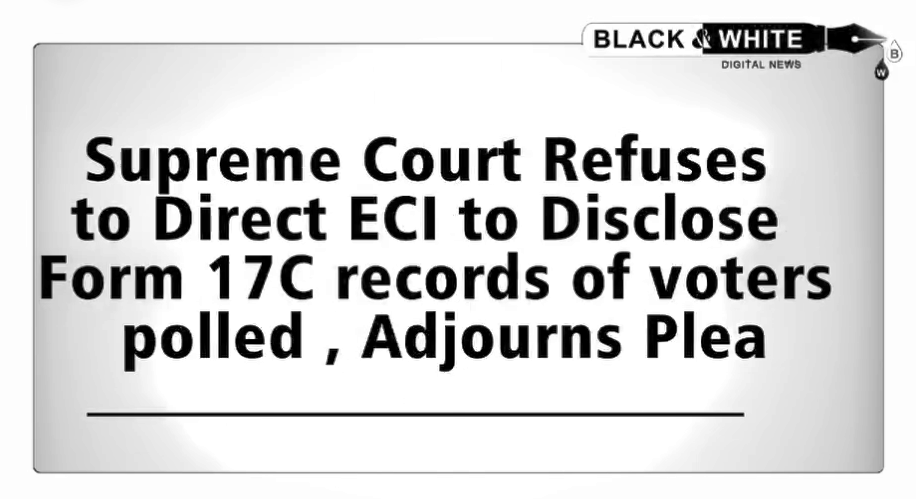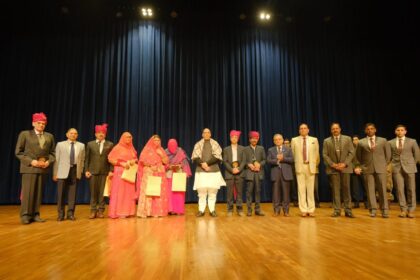**Hands-Off Approach” Amidst Elections’: Supreme Court Refuses To Direct ECI To Disclose Form 17C Records Of Votes Polled, Adjourns Plea*
||Black and White Digital News||
||Tejveer Singh,||24th May2024||
In a significant ruling during the ongoing Lok Sabha elections, the Supreme Court of India declined to issue directives to the Election Commission (EC) to upload polling station-wise voter turnout data on its website in real-time. This decision comes amid concerns raised by the Association for Democratic Reforms (ADR) over transparency and timely dissemination of voter turnout information.
**Key Details:**
1. **Vacation Bench Decision**: A vacation bench comprising Justices Dipankar Datta and Satish Chandra Sharma announced the court’s inability to issue such directives, citing logistical challenges faced by the Election Commission. The court emphasized that with five out of seven phases of polling already concluded, it would be impractical to mobilize the required manpower to comply with the request at this stage.
2. **NGO’s Plea**:
The ADR, a prominent non-governmental organization advocating for electoral reforms, filed an interim application within its 2019 Public Interest Litigation (PIL). The application sought immediate directions for the EC to upload scanned, legible copies of Form 17C Part-I (Account of Votes Recorded) for all polling stations within 48 hours of the conclusion of each phase of polling.
3. **Supreme Court’s Rationale**:
The Supreme Court bench noted that granting the relief sought in the interim application would effectively be granting the same relief sought in the main petition, which has been pending since 2019. The bench asserted, “Granting any relief in the interlocutory application will amount to granting relief in the main petition which is pending.”
4. **Election Commission’s Position**:
Previously, on May 17, the Supreme Court had sought a response from the Election Commission regarding the ADR’s plea. The EC expressed difficulties in mobilizing the necessary resources to ensure the prompt upload of the voter turnout data, given the extensive manpower already deployed for the smooth conduct of the elections.
5. **Future Listing**:
The court adjourned the interlocutory application, directing it to be listed before a regular bench post-elections. This move indicates that the judiciary recognizes the importance of the issue but prefers to address it comprehensively after the election process concludes.
**Context and Implications**:
The Supreme Court’s decision highlights the ongoing challenge of balancing electoral transparency with logistical feasibility. The ADR’s request for timely voter turnout data underscores a broader demand for increased transparency in the electoral process. However, the court’s ruling reflects a pragmatic approach, acknowledging the operational constraints faced by the Election Commission during the high-stakes national elections.
**Background of the PIL**: The 2019 PIL filed by the ADR addresses several issues related to electoral transparency and accountability. The specific request to upload Form 17C data aims to enhance public trust by providing real-time access to voter turnout information, thereby reducing the scope for discrepancies and post-poll controversies.
**Conclusion**:
While the Supreme Court has deferred immediate relief, the issue of real-time voter turnout data remains a critical concern for electoral watchdogs and the public alike. The forthcoming judicial review post-elections will be crucial in determining how future elections might incorporate more robust transparency measures without overburdening the electoral machinery. This ruling serves as a reminder of the intricate balance between maintaining electoral integrity and managing logistical capabilities in one of the world’s largest democratic exercises.
Leave a comment
You Might Also Like
Defence Minister Rajnath Singh Felicitates Second Lieutenant Arun Khetarpal’s Family During ‘Ikkis’ Special Screening
Defence Minister Rajnath Singh Felicitates Second Lieutenant Arun Khetarpal’s Family During ‘Ikkis’ Special Screening Pause Defence Minister Rajnath Singh attended…
2 Min Read
NCW Launches ‘SHAKTI Scholars’ Fellowship For Young Researchers
NCW Launches ‘SHAKTI Scholars’ Fellowship For Young Researchers Pause The National Commission for Women (NCW) has launched the ‘SHAKTI Scholars:…
2 Min Read
Ruhullah Mehdi K Kehne Se Desh Nahi Chalega Kyu Wande Matram Nhi Bologe BJP Spokesperson Thakur Abhijeet Jasrotia
Ruhullah Mehdi K Kehne Se Desh Nahi Chalega Kyu Wande Matram Nhi Bologe BJP Spokesperson Thakur Abhijeet Jasrotia #RuhullahMehdi #BJPSpokesperson…
0 Min Read
“Justice for Fire & Emergency Aspirants Will Come the Day Officers Who Took Bribes and Gave Jobs Are Removed Our
“Justice for Fire & Emergency Aspirants Will Come the Day Officers Who Took Bribes and Gave Jobs Are Removed Our…
0 Min Read









